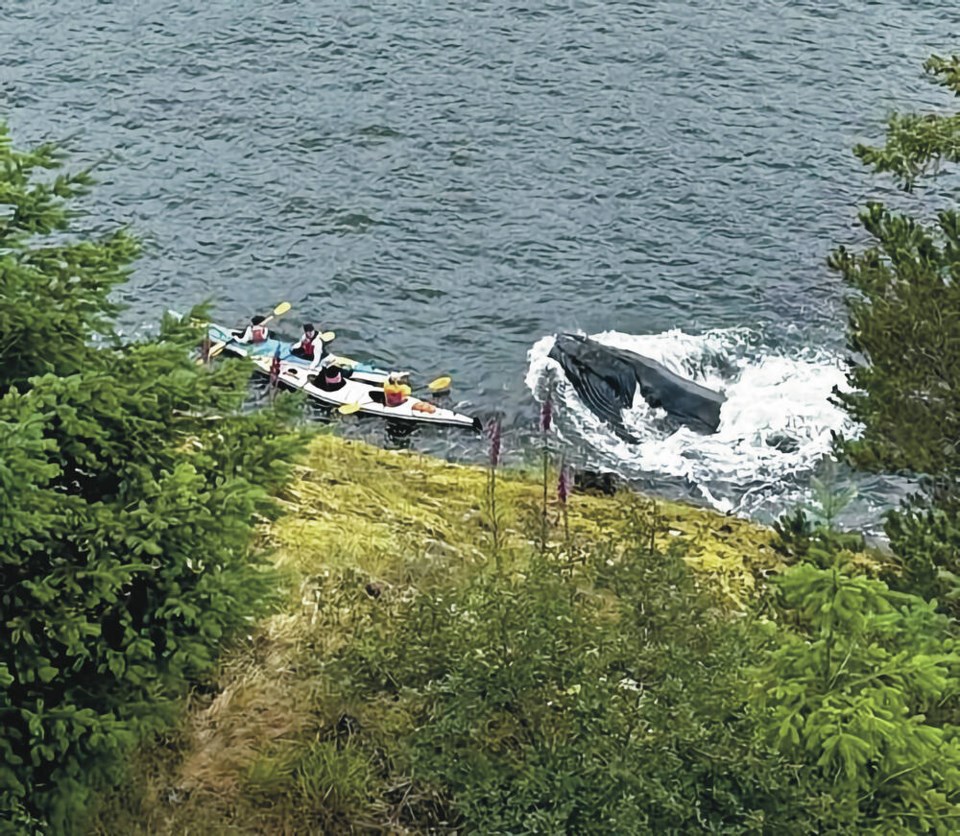Kayakers on Bowen Island had a very close and potentially dangerous encounter with a humpback whale last weekend — a reminder that the whales are focused on feeding and often oblivious to their surroundings.
Photos shared on social media by Bowen Island Sea Kayaking show a group of kayakers huddled hard against the shore as a humpback — now identified as Malachite, a three-year-old male — was lunge-feeding within a paddle’s length of the boaters and the shore.
Jackie Hildering, a humpback researcher with the Marine Education and Research Society, said the humpback whale was not showing curiosity about the boats, but feeding on schools of small fish.
Humpbacks are returning to the Salish Sea after their migrations from breeding in Hawaii, Mexico and Central America where there is little food and they are working hard to build up reserves in the Salish Sea, said Hildering.
She said humpbacks such as Malachite have “very strong site fidelity” for feeding in the Salish Sea, usually taught by their mothers. “It is so important for boaters to realize that this is what humpbacks are so often doing here … they are feeding,” she said. “Collision is a very real risk to the safety of all boaters.”
She said baleen whales are not known to have bio sonar/echolocation to interpret their surroundings. They can surface suddenly after long dives, hardly ever travel in a straight line and can suddenly become acrobatic with breaches.
When not feeding or diving, humpbacks can be sleeping or nursing near the surface and be difficult to detect.
Bowen Island Sea Kayaking owner Steve Mather did not return calls for an interview, but staff confirmed the encounter.
On social media, Mather said the kayakers saw the humpback from a distance and deliberately positioned themselves by the shore where they thought they could watch safely.
“The humpback had different ideas. Amazingly they actually captured the whole episode on video. We chose not to publish [the videos] specifically because we don’t want to encourage kayakers to get close to marine mammals,” said the post.
But the company did share photos of the encounter from a distance. “We are sharing these photos, not the kayaker’s footage, because it serves as an excellent example of just how close to shore a humpback might be feeding. And that even though effort was taken to be in a seemingly safe spot, the kayaks found themselves in an extremely dangerous position between an 80,000-pound whale and a rock wall. Thankfully everyone was OK, but it could have ended much differently.
“Hopefully we can all learn from this how unpredictable whales can be and that we need to give them lots of space.”
Bowen Island Sea Kayaking also noted it’s the law to keep 100 metres from whales — 200 metres if they are resting or with a calf — and 400 metres from all orcas in southern B.C. waters.
Hildering said “significant human injuries” can result from collisions with whales. She said kayaks and paddle boards have been flipped, boats have been disabled and people have been thrown from their boats, suffering blunt force trauma.
In June 2017, a guided fishing boat collided with a breaching humpback off Haida Gwaii. Mike Hamill, a passenger, was thrown into the air and landed on the console of the vessel. Hamill’s back was broken in three places, which left him a paraplegic.
Hildering said Bowen Island Sea Kayaking presented the right message with its social media post. “We need people to do the right things when posting these photos, that there are laws that exist that protect the whales and the people seeing them,” said Hildering.
The Marine Education and Research Society is partnering with tourism group 4VI and the North Island Marine Mammal Stewardship Association this year on a marine mammal viewing best practices program.
It urges tourists and locals who view whales and share those experiences through social media to do so with awareness of the rules and laws that protect the species and ecosystems where marine mammals live.
Online: mersociety.org/education/laws-boater-safety/
>>> To comment on this article, write a letter to the editor: [email protected]






